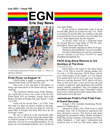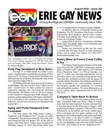Study Finds Overrepresentation of LGBTQ+ Youth in Midwest Foster Care System
The study outlined here is one of the first of its kind to be conducted in a Midwestern state, where available data on LGBTQ+ youth is extremely limited. It follows similar studies in New York City and Los Angeles showing equally high representation of youth with diverse SOGIE in foster care. Together these studies provide evidence that in the middle of the country, as well as in large urban areas, a greater proportion of LGBTQ+ youth are represented in foster care than in the general population.
The Institute for Innovation and Implementation at the University of Maryland School of Social Work (The Institute) in partnership with the Division of Children and Family Services in Cuyahoga County, Ohio (DCFS), undertook a study to collect demographic data on sexual orientation, gender identity, and gender expression of youth in the County's foster care program. The Institute undertook this study as a part of its work on The National Quality Improvement Center on Tailored Services, Placement Stability, and Permanency for LGBTQ2S Children and Youth in Foster Care (QIC-LGBTQ2S). The full results of this study can be found here:
https://theinstitute.umaryland.edu/media/ssw/institute/Cuyahoga-Youth-Count.6.8.1.pdf
Cuyahoga County Division of Children and Family Services (DCFS), Ohio, one of the selected sites, was interested in designing and implementing methods to collect SOGIE data and had made informal attempts over time with limited success. Together DCFS and the QIC-LGBTQ2S set out to determine the proportion of youth in the County foster care program that identified as having diverse SOGIE, to get better insights into their experiences in care, and identify circumstances that could be affecting their connections to family, stability of foster care placements, and overall well-being.
The current study found that just over one third (32%) of youth in Cuyahoga County's foster care system identified as LGBTQ (compared to 9.2% nationwide average of youth age 13-17 identifying as LGBTQ+). The study found that LGBTQ+ youth are at higher risk for substance abuse, placement instability, and adverse physical and mental health conditions. They were also more likely to have adverse experiences in care and more likely to be hospitalized. These findings highlight the need to identify youth in order to support them with accepting foster and school placements, and physical and behavioral health providers. Intersectionality was also indicated as the majority of youth who participated in the study identified as Black/African American (53.3%), Multiracial or Another Race (31.1%), and White (15.6%).
We need to know who the children in our care are, and what their needs are, so we can serve them. That's why this study is so important. LGBTQ+ young people were always here, but now we see them, and we can build the systems they need to feel safe, supported, and affirmed. - Cynthia Weiskittel, Director, Cuyahoga County Division of Children and Family Services.
Child welfare agencies are charged with the protection and care of children and youth who are in danger of neglect or physical and emotional abuse. The more they know about who they are serving and what their needs are, the better they can perform their protective duties. While the Children's Bureau, in leading the national efforts at child welfare, requires the collection of case and demographic data by local agencies, there is no such mandate to collect data on sexual orientation, gender identity, or gender expression. This information however is vital to meeting the needs of youth who identify as lesbian, gay, bisexual, transgender, queer, questioning, or other diverse sexual orientations or gender identities (LGBTQ+).
The more we know about the youth we serve, including sexual orientation and gender identity, the more we can make informed decisions around practice change and resource allocation. We can best meet the needs of young people when they are visible to us-if we know who they are and understand what they need. Data does that." --Angela Weeks, Project Director, QIC-LGBTQ2S, The Institute for Innovation and Implementation
The QIC-LGBTQ2S, the project in which The Institute collaborated with DCFS to produce the study highlighted here is designed to develop, implement, and evaluate evidence-informed programs for LGBTQ+ children and youth in foster care. Four child welfare agencies, including DCFS, were selected by the Institute as local implementation sites to help implement and evaluate promising models in practice settings. The ultimate goal of the QIC-LGBTQ2S is to identify practices that can serve nationwide to improve the lives of youth with diverse SOGIE. QIC-LGBTQ2S is funded by the United States Department of Health and Human Services, Administration for Children, Youth, and Families, Children's Bureau, and led by the Institute for Innovation and Implementation.
There is a critical need for prevention supports and clinical interventions that are tailored to the needs of LGBTQ+ youth and their families and designed to enhance family acceptance and reunification. This data shows that youth with diverse SOGIE are overrepresented in child welfare systems nationally, not just in major urban coastal cities. LGBTQ+ young people must be supported to thrive with their families and in their communities. -Marlene Matarese, Principal Investigator, QICLGBTQ2S, The Institute for Innovation and Implementation
The Cuyahoga County Youth Count, as this study is known, documents one of the highest known prevalence rates of LGBTQ+ youth in foster care. The 2020 report, Experiences and Well-Being of Sexual and Gender Diverse Youth in Foster Care in New York City, details the findings of 34% of youth in New York City foster care system identifying as LGBTQIA+. And the 2014 study of youth in Los Angeles, Sexual and Gender Minority Youth in Foster Care, the survey tool of which was adapted for the current study, outlines findings of 19% of foster care youth identifying as LGBTQ+.
There is a perception that LGBTQ+ youth make up a small portion of the population and that shifting practice to be more culturally responsive to their needs is not possible and it is not necessary. This study reinforces that this is not accurate. -Marlene Matarese
The Children's Bureau has prioritized LGBTQ+ youth by funding the QIC-LGBTQ2S, now in its final stages of evaluating the fifteen best practices aimed to enhance family acceptance and reunification, improve practice and system responses, and improve LGBTQ+ youth's overall wellbeing. The importance of gathering data has emerged as one of these best practices. This study points to the importance of learning more about the youth served by child welfare in order to improve policy and practice.
###
The Institute for Innovation & Implementation (the Institute), founded in 2005, is a part of the University of Maryland School of Social Work. The Institute is committed to building research-based, inclusive, culturally responsive, and transformative child-, youth-and family-serving systems and services, and to developing the capacity of the workforce within these systems. We do this work in partnership with government agencies, health care providers, youth and their families, and community-based organizations in order to improve outcomes for and with children, youth, and their families. Find The Institute: https://theinstitute.umaryland.edu
Cuyahoga County, Ohio is focused on economic growth and opportunity, fairness and equity and a government that gets results. We believe that we can create and support a vibrant and prosperous region where everyone thrives, and all things are possible. For more information on Cuyahoga County please visit cuyahogacounty.us. Follow us on social media: Facebook: https://www.facebook.com/CuyahogaCounty Twitter: https://twitter.com/CuyahogaCountyInstagram: https://www.instagram.com/cuyahogacounty/
Sign up for our newsletter: https://cuyahogacounty.us/county-news/newsletter-registration




